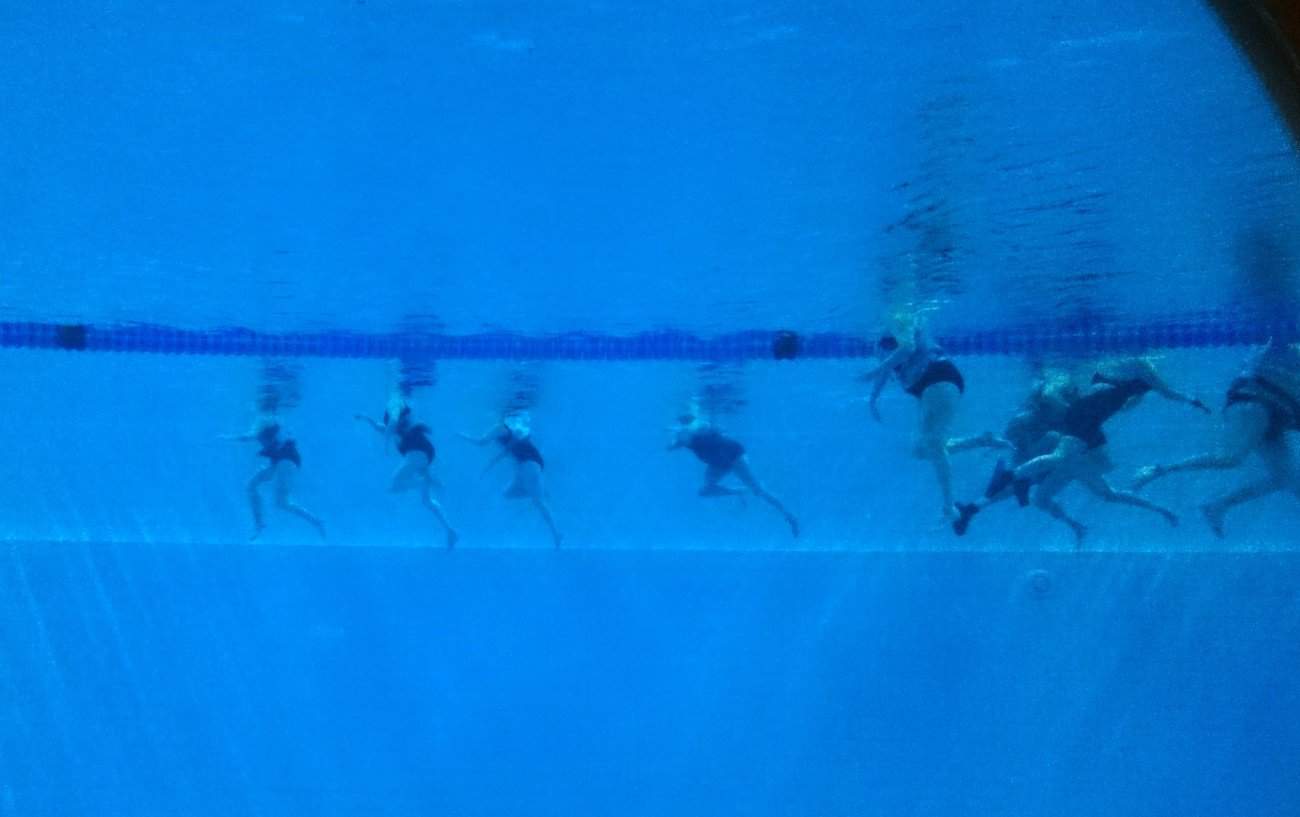Cross training for runners is essential to a sustainable, healthy, strong, and injury-free running journey.
Cross-training involves mixing up your training program with other activities—such as weight training, yoga, or swimming—to help you level up your running, keep you injury-free, and hit new PRs.
However, when done incorrectly, cross-training can negatively impact your running game.
We spoke with running coaches and health experts to help you safely enhance your running performance by adding cross-training to your weekly training plan.
In this complete guide to cross training for runners, we will discuss the benefits of cross-training, how it can help prevent injuries, and how to effectively incorporate it into your schedule.

What Is Cross Training For Runners?
Cross training for runners is any activity that is complementary to your running training, and makes you a better runner.
It’s important to note that not all cross training is created equal. Some activities are more specific and helpful than others.
Different forms of cross-training can:
- Reduce the risk of a running injury
- Improve your cardiovascular and muscular endurance
- Build strength, which can improve your endurance and running economy
- Provide a mental and physical break by switching up your training
- Allow injured runners to maintain their running fitness while off their feet
Every different cross training activity has pros and cons when related to your running fitness.
Yoga, for example, is great for mobility and strength, but isn’t as effective as a good gym session for building muscular endurance.
We’ll discuss the different types of cross-training for runners, but first, let’s consider the benefits.

What Are The Benefits Of Cross Training For Runners?
Overall, cross-training makes you a well-rounded running machine by building strength and endurance and minimizing weak spots where injuries or imbalances can develop.
“The majority of running-related injuries are tied to overuse. Most overuse injuries can be prevented1Ferber, R., Hreljac, A., & Kendall, K. D. (2009). Suspected Mechanisms in the Cause of Overuse Running Injuries: A Clinical Review. Sports Health: A Multidisciplinary Approach, 1(3), 242–246. https://doi.org/10.1177/1941738109334272 or at least prevented from returning” explains Steve Stonehouse, certified Run Coach and Director of Education for STRIDE.2LLC, S. F. (n.d.). Run With STRIDE Fitness | Homepage. Www.stridefitness.com. Retrieved March 11, 2024, from https://www.stridefitness.com/
This means cross-training is especially useful for . . .
- Runners returning after an injury
- Runners running high volume
- New runners
“The truth is that if you quiz any seasoned, successful runner who hasn’t had injury downtime in the past year or two, they’re bound to tell you they stick to a good cross-training plan,” says, Thomas Watson, Marathon Handbook coach.
“If you’re a beginning runner who hasn’t yet developed strength and flexibility, you can get big benefits from endurance cross-training,” explains Stonehouse.
“Your ankles, knees, and lower back aren’t used to the repetitive impact of running, so you can use cross-training to improve endurance without beating up your most vulnerable joints, muscles, and connective tissues.”
How Does Cross-Training Prevent Injuries?
Cross-training helps prevent injuries because the cardiovascular and muscular systems strengthen at a faster rate than the skeletal system.
“Muscles adapt relatively quickly, but tendons and ligaments take much longer to do so,” explains Todd Buckingham, lead exercise physiologist at Mary Free Bed Hospital.3Mary Free Bed Rehabilitation Hospital: Home. (n.d.). Mary Free Bed Rehabilitation Hospital. https://www.maryfreebed.com/
“The reason is that tendons and ligaments don’t have the same blood flow that the muscles do, so it takes them longer to adapt to the stresses placed on them through exercise.”
Thus, if you try to progress with only running too quickly, you could end up injured. This makes cross-training a perfect complement to a new runner’s arsenal.

Is Cross-Training Good For Runners?
Yes, cross-training is good for runners.
In fact, no matter what level of experience you have as a runner, cross-training should be part of your running schedule.
5 Reasons All Runners Need To Cross Train
#1: Helps Prevent Injury
Running involves repeating the same motion, usually in one direction, thousands of times. Naturally, this leads to imbalances in our kinetic chains. One muscle tightens, another weakens, and the next thing you know, your runner’s knee flares up.
Cross-training allows runners to address those imbalances. It can also help prevent injury by strengthening muscles and supporting ligaments and tendons.
#2: Improves Running Economy and Endurance
Specifically, when we get into strength training and targeting the legs, you can make some real gains in your running economy (essentially your miles-per-gallon as a runner) and your endurance.
Stronger legs, hamstrings, quads, calves, and glutes, combined with proper running form, make runners more efficient.
They also help you last longer – stronger legs have been shown to fatigue slower in endurance events. Full-body strength training will also help you maintain good running form in longer events like marathons and ultramarathons.
#3: Allows You To Target Specific Deficiencies
Cross-training allows runners to train in specific fitness areas without adding unnecessary miles.
For example, a runner who wants to work on cardiovascular fitness could do an elliptical session or go swimming.
While a runner who wants to improve their running economy can hit the gym.

#4: Prevents Burn-Out And Over-Training
Many runners will run miles and miles on end, day after day.
However, doing the same thing over and over will work only those specific running muscles, which could lead to overuse injuries, overtraining syndrome, and mental burnout.
Cross-training—whether it’s yoga or even a round of golf with some friends—can not only give you a break from running but also provide a needed mental state change that can promote recovery.
#5: Makes You Multi-Purpose
What good is being able to run 100k if you can’t even do a couple of pull-ups or push-ups?
In my experience, people with consistently happy and healthy running careers know the value of being multi-disciplined.
Having some athletic range—whether it’s to play football, know your way around the gym, play with your kids, or go mountain biking with friends—is a life skill.
#6: Can Accelerate Recovery
Light cross-training activities like cycling or the elliptical can improve muscle blood flow, thereby accelerating recovery time between runs – think of them as active rest days.
Is Strength Training A Form Of Cross Training?
Yes, and it’s arguably one of the best forms of cross training for runners.
Why?
Strength training specifically targets the areas neglected or weakened by running and boosts those leg muscles in a way that regular running doesn’t (more akin to hill running, perhaps).
In other words, strength training helps injury prevention, improves running economy, and improves endurance.
What type of strength training is most effective?
Simply put, weightlifting.
Focus on lifting heavier weights that target your legs in your lower body and core, and you’ll soon notice the gains in your running performance.
Here’s our full guide to Weightlifting for Runners
Related: Should You Do Cardio and Weights On The Same Day?
Is CrossFit A Good Form Of Cross Training For Runners?

CrossFit is often controversial due to concerns about injuries when handling heavy weights and using proper technique, but it can be used as cross training for runners – with some caveats.
CrossFit combines both strength training and HIIT (high-intensity interval training)-style anaerobic workouts into one high-octane session. I’ve spent a few months training in my local CrossFit box before, and have some thoughts on it:
- The strengh training aspect of CrossFit can definitely be beneficial to runners, much like weightlifting. A stronger runner is less injury-prone and has been running economy.
- However, the HIIT-style training method can be counterproductive for runners—especially if you’re trying to maintain or improve your run training. It’s an intense cardio workout that can leave you totally drained and with less energy to run in the following days.
My general recommendation is that runners instead incorporate those HIIT-style workouts as running exercises: either hill running, hill sprints, fartleks, or intervals like Yasso 800s.
- CrossFit inevitably does introduce the risk of getting injured, even when done well.
If you’re a runner who is interested in CrossFit (or vice versa), my recommendation is not to blend these two activities when you’re training for a race.
Perhaps in your off-season, you can spend more time in the box as a nice gear change from running, but don’t try to add CrossFit WODs into high-mileage weeks – that’s a recipe for burnout!
What Are The Best Cross Training Exercises For Runners?
There is no one-size-fits-all cross-training exercise for runners – remember that every activity has pros and cons that will benefit or could hinder your running performance.
Runners should choose a low impact exercise that compliments their running and preferably includes some strengthening work.
Cross Training Activities To Consider Avoiding
Some activities can be harmful to runners because they involve quick lateral movements that increase the risk of injury.
“Runners may want to think twice about exercises that require fast movements with a lot of change in direction such as tennis, basketball, soccer, or downhill skiing,” explains Buckingham.
“Because a runner is used to moving in one plane of motion (forward), adding these activities to a runner’s repertoire too quickly could result in injury.”
“Runners can and should do lateral movements in a controlled environment to strengthen often-neglected muscles,” Buckingham adds.
“The speed of those movements should be slow and controlled with minimal twisting to avoid injury. As runners, we spend most of our time trying to get better at running. It would be silly to hurt yourself doing something for fun and then being unable to run,” he says.

10 Of The Best Crosstraining Activities For Runners
Here, I’ll run through a pretty exhaustive list of activities and sports and discuss their suitability as cross-training for runners.
In no particular order, let’s get started:
#1: Strength Training
Great for: muscle strength, endurance, and injury risk reduction.
Strength training means performing a resistance workout on your muscles – usually a bodyweight workout or a gym session.
For the biggest bang for your buck, I highly recommend lifting some weights and focusing on compound exercises that work several of the big muscle groups at once.
This means exercises like weighted squats, lunges, deadlifts, bench presses, and kettlebell exercises.

#2: Swimming
Great for: low-impact cardio, full-body workout
Swimming is an awesome recovery day workout for runners.
It’s a solid cardiovascular workout that is easy on the muscles, joints, ligaments, tendons, and bones because it is non-weight-bearing—it’s almost like giving your body a nice stretch and massage session with some cardio thrown in.

#3: Aqua Jogging
Great for: zero-impact running rehab
While at the pool, try aqua jogging – essentially running while treading water. You should get a flotation belt to do it properly. It’s particularly popular with injured runners as a form of rehabilitation.
It is non-weight bearing, works the neuromuscular system like running, and is a tremendous aerobic workout. To make it more difficult, put your arms above your head.

#4: Cycling / Biking
Great for: cardio, leg strength, mobility
Cycling or biking works the major muscle groups in your legs just like running; it works your cardiovascular system to make you fit.
But it does this without the pounding that running does, allowing both the benefits of fitness and recovery.
Cycling can also aid in mobility for running.
Check out our sister site BikeTips, for everything cycling-related.

#5: Yoga and Pilates
Great for: mobility, reducing injury risk, breathwork, strength, and conditioning
Yoga and pilates are distinct, but both have similar – and awesome – potential benefits on your running game.
They each provide a great deal of mobility work, and are well-known for reducing the risk of injury as well as helping correct bad running form which comes from imbalances in the kinetic chain.
Depending on the type of workout, they can also provide some solid core strength training.
I also want to highlight the breathwork element of yoga and pilates – if you become a better breather, this translates to better running performance. Not only are you more likely to breathe more comfortably when you run, but that breathing can translate to better endurance and faster recovery.
Check out our friends at yogajala for buckets of advice for getting started, as well as how to balance yoga and running in your training plan.

#6: Elliptical (or Elliptigo)
Great for: low-impact cardio, mimicking running
Doing the elliptical or even better, the Elliptigo, has the same benefits as cycling or biking: it works the muscles, heart, and lungs while mimicking running without the impact and stress to your body.
A great cardio workout!

#7: Walking and Hiking
Great for: low-impact cardio, active recovery
Walking is one of the best activities that mimics running and gently adds some stress to bones, muscles, and connective tissues to further strengthen these systems.
Walking is a wonderful cross-training activity for active recovery between hard running workouts.
Hiking is turning things up a notch, and incorporating trails, gradients, and uneven terrain into your walk. Both are highly recommended, especially if you can get outdoors and give your brain a little dopamine boost to accelerate your recovery.

#8: Golf
Great for: low-impact cardio, active recovery
That’s right, you have full permission to head out for a round of golf as a runner.
Why?
It’s mainly because it’s a very relaxing activity. It is likely to encourage a parasympathetic ‘rest and recover’ state and speed up recovery after your last run.
It’s also a nice change of gear physically – you’re never straining during golf, and the gentle walk has some cardiovascular benefits

#9: Team / Ball Sports
Great for: cardio and mental shift
Football, tennis, and basketball have similar pros and cons. They’re great cardio workouts and very mentally engaging, but they don’t do anything specific for your running game and can both hinder recovery and increase the likelihood of an injury.
For those reasons, they’re not great cross-training activities. If you’re already part of a team and decide to take on half marathon training, for example, then, by all means, keep up your weekly games.
But I wouldn’t recommend starting a new ball sport if you’re a runner looking to improve.
How Many Days A Week Should A Runner Cross Train?

The amount of weekly cross-training sessions for runners varies depending on the runner and their goals and other pursuits
Generally I like to recommend two strength training sessions per week, plus another cross training session – yoga or swimming being good options.
When in the throes of a high mileage training plan, we’d maybe dial this back to 1 or 2 cross training sessions a week, to keep you strong and injury-free without pushing you too hard.
“The benefits of cross training for runners are there a hundred percent of the time,” says Stonehouse. “When you CAN’T run, cross-training indoors can help you maintain (or even gain in some cases) strength and endurance.”
How Can A Runner Include Cross-Training In Their Training Schedule?
Beginner runners will likely cross-train every other day for 2 to 4 days as their bodies adjust to running.
More experienced runners will likely cross train less as they run more.
Their cross-training activities will help them recover faster or give their legs a rest while they still work their cardiovascular system. More advanced runners will typically cross train one to two times per week.
“More advanced runners can use cross training to replace recovery runs,” explains Stonehouse. “This becomes their active recovery between crucial running workouts like speedwork, tempo runs, and long runs.”

How Can I Not Get Bored When Cross-Training?
If you are cross-training indoors, it can be boring.
Beat boredom by using technology! Watch movies or TV shows, listen to podcasts or audiobooks, or jam out to music. For recovery workouts, you can read while on the bike or elliptical, for example.
What Are The DOs Of Cross-Training?
Here are 6 DOs of Cross-training for runners:
- “Do incorporate cross training regardless of whether you are a novice or experienced runner,” says Buckingham.
- Do keep your cross-training easy when it’s a recovery cross-training session or after a challenging running workout.
- Do warm-up and cool-down before a cross-training session as you would before a run.
- Do choose the type of cross-training you enjoy that fits the purpose of what you need on that day, whether focusing on endurance, strength, flexibility, or something else, advises Stonehouse.
- Do find a running coach to help guide you in how to best incorporate cross-training to stay healthy and get stronger, adds Stonehouse.
- Do wear a heart rate monitor to ensure you stay in the appropriate heart rate zone for your workout.
What Are The DON’Ts Of Cross-Training?
Here are 5 DON’Ts of Cross-training for runners:
- Don’t do too many new types of cross-training too soon. Doing so could result in injury, says Buckingham.
- Don’t treat a cross-training workout as something you just have to “get through”. “Cross-training can have similar benefits to a running workout and can be very beneficial in your training,” he adds.
- Don’t skip your run to do a cross-training session. It might be hard to believe, but to be a better runner, you actually have to run!
- Don’t push hard in your cross-training sessions unless that is the purpose of the workout. Stay true to the goal.
- Don’t let cross-training distract you from your running goal. “Sometimes we can add so many ‘other’ things that the additional volume is just too great,” warns Stonehouse. This can put you at risk for burnout.

Can You Cross Train And Run On The Same Day?
More advanced runners will often run and cross train on the same day.
Why?
Because cross-training can help the runners more quickly recover from an intense or long running workout.
In this case, cross-training acts as an active recovery for runners. Active recovery is a low-intensity workout that promotes blood flow, thereby accelerating recovery in between runs.
Active recovery has been found4Dupuy, O., Douzi, W., Theurot, D., Bosquet, L., & Dugué, B. (2018). An Evidence-Based Approach for Choosing Post-exercise Recovery Techniques to Reduce Markers of Muscle Damage, Soreness, Fatigue, and Inflammation: A Systematic Review With Meta-Analysis. Frontiers in Physiology, 9(403). https://doi.org/10.3389/fphys.2018.00403 to:
- Increase blood flow to damaged muscles
- Reduce lactic acid buildup in muscles
- Remove exercise-induced metabolic waste in muscles
- Reduce muscle tears and pain
The best cross-training activities for active recovery include walking, cycling, swimming, and elliptical. Anything that is low intensity and moves the body can be an active recovery exercise.

What Is A Good Cross-Training Schedule For Runners?
Here is a sample cross-training schedule for a beginner runner:
- Monday: Easy run for 30 minutes
- Tuesday: Cross-train for 45-60 minutes
- Wednesday: Easy run for 45 minutes
- Thursday: Cross-train for 45-60 minutes
- Friday: Rest day
- Saturday: Easy run for 45-60 minutes
- Sunday: Rest day or light cross-train for 30-45 minutes
Here is a sample cross-training schedule for an advanced runner:
- Monday: Easy run for 8 miles
- Tuesday: Interval or tempo run in the morning + Cross-train for 45 minutes in the evening
- Wednesday: Mid-week long run for 10-12 miles
- Thursday: Interval or hill workout in the morning + Cross-train for 45 minutes in the evening
- Friday: Easy run of 4 to 6 miles or light 30-45 minutes cross-train
- Saturday: Long run of 12 miles or more
- Sunday: Easy cross-train for 30-60 minutes

If you need help with your running goals from the half marathon to ultramarathon distance, check out our running resources.













3 thoughts on “The Ultimate Guide To Cross Training For Runners”